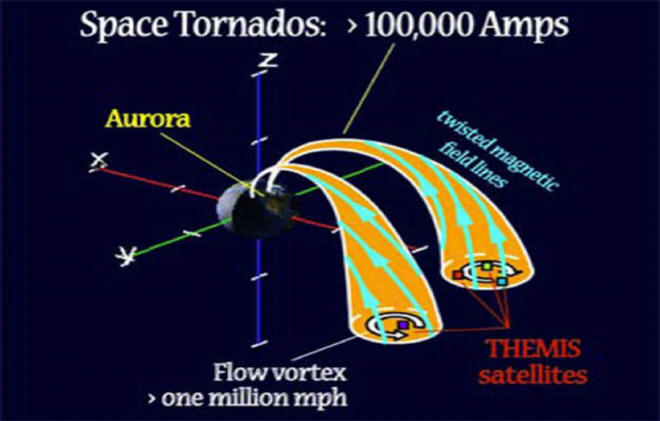Space Tornadoes Cause a Stir
Nov
27, 2009
The idea of a giant radiant
pillar rising up from the earth to
the sky would have sounded too
fantastic to be true – until
recently.
In April of 2009, NASA’s fleet of
THEMIS satellites detected vast
electrical tornadoes about 40,000
miles above the night side of the
earth, on the boundary between the
solar wind and the earth’s
magnetosphere.
Since the 1990s, a handful of
‘plasma mythologists’ had assumed
the former existence of a
stupendous, luminous sky column that
was visible from almost every part
of the earth. The evidence for this
was the prominent place allotted to
this axis mundi or ‘world axis’ in
detailed cosmological traditions
from hundreds of cultures dotted
around the globe.
The column was widely portrayed as a
prodigious mountain, tree, rope,
bridge, ladder or pathway and was
universally characterised by notions
of centrality, vitality, vorticity,
and luminosity: the conspicuous
position it occupied in the
firmament earned it an association
with the ‘navel’, ‘heart’ or
‘centre’ of the world; its agility
made it seem as if it was imbued
with life, like a giant divine
creature breathing life into the
surrounding cosmos; its filamentary
extremities were subject to warping
and twisting, while the column
itself was seen to be entwined by
spiralling filaments frequently
compared to snakes; and the
splendour of the light it emitted
repeatedly invited comparison to the
sun and to lightning.
Scores of mythical traditions from
all inhabited continents detail the
eventual collapse and disappearance
of this mighty lightning-like
pillar. The Maya of Valladolid,
Yucatán, recalled the existence of
“a road suspended in the sky” over
the peninsula: “For some reason this
rope was cut, the blood flowed out,
and the rope vanished forever.”
The Mocoví, of the South American
Gran Chaco, reported that the tree
Nalliagdigua, which was “so tall
that it reached from the earth to
the sky”, was felled by “an old
woman”. A pre-Buddhist tradition of
Tibet related the downfall of
dmu-thag, the “spirits rope” or
“spirits ladder” joining the layered
heavens, which the mythical kings
used to traverse: “As a result the
two worlds have remained for ever
parted.” The motif of axial
disruption received little attention
from comparative mythologists in
general, but it did inspire
researchers exploring the role of
plasma in mythology to conclude that
our ancient forebears had witnessed
a transient event whose magnitude
has not been rivalled in the past
3,000 to 5,000 years.
The model required a scientific
mechanism to be plausible. Insofar
as any energetic plasma activity in
the upper part of the earth’s
atmosphere is classified as
‘auroral’ by definition, an auroral
storm of unprecedented intensity
seemed to be at the root of the
traditions. Too often, specialists
in human traditions still conceive
of the solar system as a sterile,
Copernican region, in which planets,
comets and asteroids are the only
bits of matter traversing an
otherwise absolute vacuum with
clockwork precision. This view is
long obsolete in science.
It is now clear that the ‘solar
wind’ conveys charged particles from
the sun towards the earth, where the
geomagnetic field deflects them to
the night side of the planet.
Occasional ‘leaking’ into the
ionosphere through giant apertures
then sparks bursts of auroral
display. The solar system emerges as
a finely structured framework of
electromagnetic forces, currently
quiescent except for the occasional
coronal outburst of the sun.
The exact mechanism of plasma
transmission remains a vexing
puzzle, however. Ever since solar
weather was identified as the
ultimate cause of geomagnetic
fluctuations, scientists suspected
that solar plasmas reach the
ionosphere through ‘plasma cables’
known to plasma physicists as
Birkeland currents – but the
existence of these remained
hypothetical.
In a groundbreaking discovery,
NASA’s five THEMIS aircraft,
designed to measure the magnetic
field of the earth, have now
identified giant swirling space
tornadoes, the size of the earth or
larger in diameter, that channel
electrically charged particles at
speeds of more than a million miles
per hour along twisted magnetic
field lines into the ionosphere of
the earth, where they power the
auroras.
Stretching thousands of miles into
space and exceeding the earth in
diameter, these whirling vortices
are clearly the modern equivalent of
the hypothetical Birkeland currents
that spawned human stories about a
past resplendent sky column.
Structurally akin to the
hypothesized axis mundi that
dominates the world’s creation
myths, these “space tornadoes” are
highly dynamic, funnel-shaped and
current-carrying structures governed
by the same laws of plasma physics
and prone to the same types of
changes in morphology and behavior
that account successfully for the
mythical traditions.
The difference between the mythical
column and the tornadoes observed
today appears to be one of scale
only: an unusually strong
bombardment of charged particles
onto the ionosphere could have
triggered the formation of a single
collimated Birkeland current, of a
semi-permanent nature, that was
susceptible to a type of plasma
instabilities known as ‘Peratt
Instabilities’.
Crucially, the electric discharging
occurring on this occasion will have
been intense enough for the ‘dark’
plasma of the tornadoes as well as
the solar wind to switch to glow or
indeed arc mode, forcing the
dazzling likeness of these space
marvels onto the unprotected eyes of
living beings on earth.
Contributed by Rens Van der Sluijs
http://mythopedia.info
Books by Rens Van
der Sluijs:
The Mythology of the World Axis
http://www.lulu.com/content/1085275
The World Axis as an
Atmospheric Phenomenon
http://www.lulu.com/content/1305081
|







